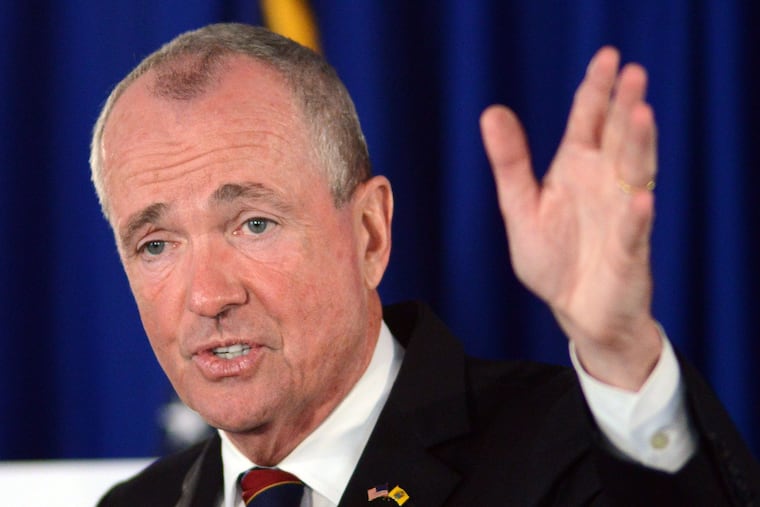Obamacare insurance rates to fall 9.3 percent in New Jersey
Murphy credited two state laws he signed in May for producing the rate reduction: a measure creating an individual health insurance mandate, and a law establishing a reinsurance program.

Individual health insurance rates in New Jersey will decrease on average by 9.3 percent for 2019, a far cry from the 5.8 percent average rate hike carriers requested earlier this year, Gov. Murphy announced Friday.
Murphy credited two laws he signed in May for producing the rate reduction: one creating an individual health insurance mandate, and another establishing a reinsurance program.
The laws were a response to the federal tax overhaul President Trump signed in December. That law scrapped the individual mandate included in the Affordable Care Act (ACA), commonly known as Obamacare.
"Our work is based on the core belief that health care is a right — not a privilege," Murphy, a Democrat, said in a statement. "Federal attacks on the Affordable Care Act and rising costs of health care have made premiums less affordable for residents buying plans on the individual market. We have taken deliberate actions to defend the gains made by the ACA, and our work is demonstrating results."
>>READ MORE: Even after political assaults, Obamacare is looking much healthier
Without the state laws, the average requested rate increase for next year's individual Obamacare plans would have been 12.6 percent, according to New Jersey's Department of Banking and Insurance.
The state's individual mandate, which will require Garden State residents to have health coverage or pay a penalty, reduced that average requested rate hike to 5.8 percent, the department said in July.
In August, the state received federal approval to create a reinsurance program, which will help insurers cover the cost of the most expensive Obamacare patients. That approval resulted in a total average rate decrease of 9.3 percent, the governor's office announced Friday.
The reinsurance program will reimburse 60 percent of individual claims between $40,000 and $215,000 in a single year, according to the governor's office.
>>READ MORE: New Affordable Care Act insurance choices for 2019 in Southeastern Pa.
The state will use revenue generated from state individual mandate, federal funds received as part of the program's approval, and if necessary, an annual appropriation from the state budget's general fund to pay for the reinsurance.
New Jersey's Office of Legislative Services (OLS), which analyzes the fiscal impact of state legislation, could not determine in April how many Garden State residents may be subject to the state individual mandate.
In 2015, nearly 189,000 New Jerseyans collectively paid $93 million in fees, averaging roughly $500 per person, for not complying with the federal mandate, according to OLS.
The state individual mandate takes effect Jan. 1. Open enrollment for 2019 plans begins Nov. 1. New Jersey's individual health insurance market had about 330,000 people in it in the first quarter of this year.
New Jersey became the second state to adopt an individual mandate in May, followed by Vermont in June. Massachusetts was the first state to enact an individual mandate, in 2006. That law served as a model for the mandate included in the Obamacare, which was signed in 2010.
In July, the Pennsylvania statewide average rate increase request was just 0.7 percent, according to the Pennsylvania Insurance Department. Final rates will be announced in the fall.
Rates stabilizing nationwide
The consulting firm Avalere Health and the Associated Press crunched available state data, finding that Obamacare's health insurance marketplaces seem to be stabilizing. Customers in some states, like New Jersey, will get price cuts. And the exodus of insurers from the program has halted, even reversed somewhat, with more consumer choices for 2019.
The analysis found a 3.3 percent average increase in proposed or approved premiums across 47 states and Washington, D.C., for next year. This year, the average increase nationally was about 30 percent. The average total premium for an individual covered under the health law is now close to $600 a month before subsidies.
For next year, premiums are expected either to drop or increase by less than 10 percent in 41 states with about 9 million customers. Twelve of those states are expected to see a drop in average premiums. In six other states, plus Washington, D.C., premiums are projected to rise between 10 percent and 18 percent.
Insurers also are starting to come back. Nineteen states will either see new insurers enter or current ones expand into more areas. There are no bare counties lacking a willing insurer.
Even so, Chris Sloan, an Avalere director, says, "This is still a market that's unaffordable for many people who aren't eligible for subsidies."
Nearly 9 in 10 ACA customers get government subsidies based on income, shielding most from premium increases. But people with higher incomes, who don't qualify for financial aid, have dropped out in droves.
Business analysts say the relatively good news for 2019 is partly the result of previous premium increases, which allowed insurers to return to profitability after losing hundreds of millions of dollars.
"They can price better, and they can manage this population better, which is why they can actually make some money," said Deep Banerjee of Standard & Poor's.
The Associated Press contributed to this article.